Yes, Star Wars fans, we are a blessed group as another season of Star Wars: Visions has arrived, coming to Disney Plus on the holiest of days, May 4th. With Lucasfilm licensing out a season of shorts to nine different studios, all giving it their best shot.
While the first season was “anime” focused, with the nine shorts being produced by Japanese animation studios only, this season has a more international flair, seeing contributions from studios in Spain, Ireland, and South Africa just to name a few. And while I certainly loved the first season, being a massive anime fan, allowing studios from around the world to chip in was clearly the right move. The end result is a much more ambient season of Visions, making for a better product overall, and I’m here to tell you, it’s pretty fucking great.
Visions to me is less about studios bending the knee to Star Wars and more about Star Wars acknowledging the interrelationship it has with other forms and structures. Indeed, one of the great things about the Feudal Japan inspired The Duel from S1 and the equivocal accompanying novel Ronin, was the franchise straight up flexing its Kurosawa roots in a very real, very tangible way. Not that they were denying it of course, but to embrace in a way that allowed for holistic storytelling was refreshing to see from LFL, something historically reserved for fan-films.
So, fast forward to 2023, and we’ve now got two whole wonderful seasons of Visions to enjoy. This time around I’ve decided to do a Top 5 instead of reviewing all nine shorts, a few of which really didn’t require a deeper understanding to interpret or appreciate what’s happening, enjoyable as they might be. On the flip side, these five stirred something in me that that made them impossible to ignore, pitting something inside of me that needed to get out, a monster in the basement.
So, without further ado, here they are, my five favorite shorts from Season 2, in order, yes…in…order.

AAU’S SONG
Studio: TRIGGERFISH
Directed by: Daniel Clarke, Nadia Darries
Written by: Nadia Darries, Daniel Clarke, Julia Smuts, Louw
“An alien child who longs to sing is raised by her loving, but stern father to stay quiet because of the calamitous affect her voice has on the crystals in the nearby mines.”
Yes, my favorite of the lot also happens to be the final episode of this sophomore season as AAU’S SONG is absolutely perfect in my mind. This coming out party for Nadia Darries, clearly a renaissance person, does everything right including an incredible score by Markus Wormstorm (great name) and The Cape Town Youth Choir. Darries herself kicks in an indelible vocal performance, and along with Daniel Clarke, directs a beautiful and heartfelt piece of storytelling.
It’s compelling from the very beginning, kicking off with a homogenous blurb (the only one that does this), explaining how the Sith corrupt kyber, poison it red, and Jedi purify it. Also introducing us to Korba, a planet where people mine already corrupted kyber, cleansing it for the sole purpose of helping the Jedi. At the onset we meet the Korban father/daughter duo of Abat (Tumisho Mashs) and Aau (Mpilo Jantjie/Dineo Du Toit), the former of which receives a visit from Atu (Faith Baloyi), a very cool Jedi looking for a restored crystal.
Turns out the very precocious Aau, defying her father’s wishes by eavesdropping through a window, has a gift, a “song” which connects her to the crystals, they call to her. But it’s unpredictable, dangerous even. Unable to fully control it, the “voice” gets triggered by the crystal, leading the Jedi to take notice. On a side note, this melody is the reason for two actors, one (Jantjie) handles the dialogue, while the other (Toit), the singing. And so, after a near-miss mining accident where Aau is forced to use her gift in an extraordinary way, Atu offers Aau a spot on her ship, a chance to fulfill her true potential. This leads to a morose yet hopeful farewell scene between Aau and her father, as she goes off in search of adventure, her destiny. It’s emotional, it’s beautiful, and it’s perfect.
On the production side, the details in this short are off the charts good with beautiful lighting and textures, credit to Art Director Philipe Rios and Lighting Supervisor Andrew Wilkins. Particularly striking are the scenes in which Aau enters her aria state, her bond with the crystals happening on an ethereal plane, both unnerving and beautiful. In this astral type of space, her voice creates a misty veil that envelopes the poisoned kyber, overwhelming the darkness emanating from them, attenuation occurs. It’s very, very fucking cool. And The decision to use felt animation was clearly an inspired one as the benefits of the medium are clear, eliciting a very chaste viewing experience. The textures allow for a folksy feel which of course syncs up very well with the environment, softening up these alien characters, humanizing them. Yes, the “uncanny valley” relationship is in full effect as these “aliens” will most certainly evoke an emotional response from you, how could then not. The end result is a level of comfort you don’t always get from the more garish or gaudy animation styles we sometimes see.
And as far as character work goes; they get so much out of so little it’s a revelation. Understand that there is basically almost no dialogue in this short, and yet you’re never feeling nonplussed, or even more remarkable, disinterested. Aau demands your attention, her mere presence creating a stupefying effect, a quiet calm. She’s enchanting.
So, yes, AAU’S SONG is my favorite of the bunch, in fact, I’m not even sure it’s close.
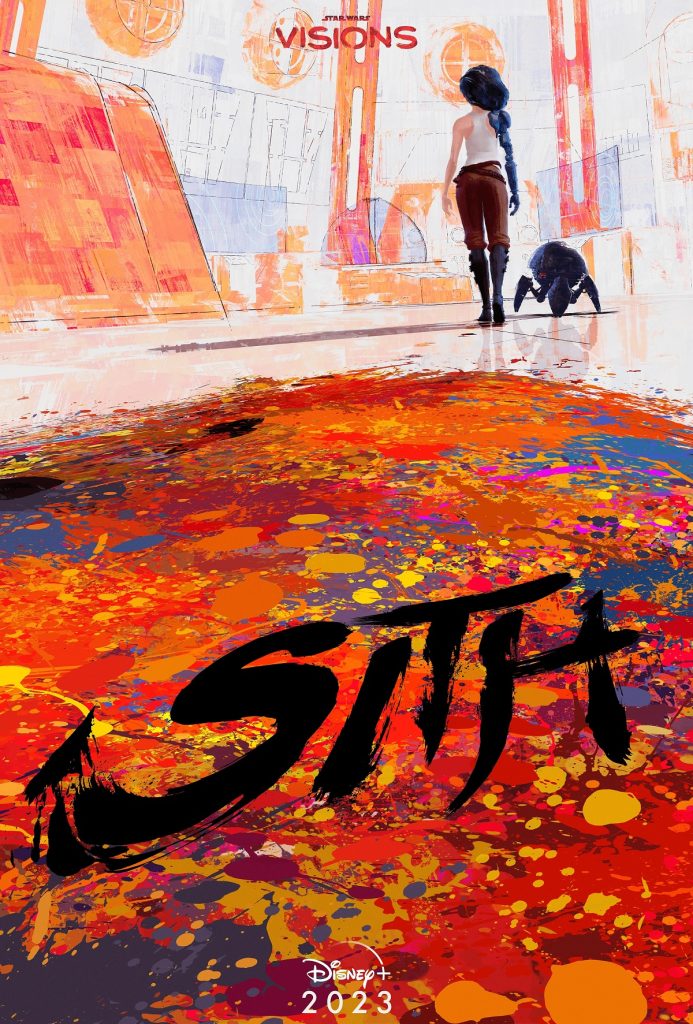
SITH
Studio: El Guiri Studios
Written/Directed by: Rodrigo Blaas
“A former Sith apprentice, leading a peaceful, but isolated life, is confronted by the past when her old master tracks her down.”
The second season starts off with a total banger, a level which would have the rest of the season playing a game of catchup I’m afraid, certainly visually. The fact that the season is bookended by my two favorite entries certainly pleases the part of my brain that prefers symmetry. And this balanced nature is something that comes up not only in Sith but is a reoccurring theme throughout the rest of the season.
As the blurb says, we have Lola (voiced superbly by Úrsula Corbero), who along with her droid E2, is leading an isolated existence on an unknown planet. They’ve turned an Imperial ship (theirs I’m assuming) into not only a home, but in the case of Lola, a workspace. Force inclined, she spends her days transforming the ship into a work of art, manufacturing one iconoclastic piece after another, slowly transmuting her surroundings into an array of beautiful specters. Her force abilities allow her to create three-dimensionally which she uses to fill her world with living breathing color, but there’s clearly a darker influence she can’t seem to overcome, a shadow.
A meteorite investigation turns into an encounter with a Sith master (Luis Tosar) and a pair of goons, who she takes care of quickly with a little help from E2. Now, if you’ve seen the S2 trailer then you’ve seen the scary looking Sith dude, and he is that, chillingly stalking Lola to her base, doing his best Voorhees impersonation. We learn she turned her back on him some time ago, renouncing the dark side in favor of the light, of color. And since this Sith clearly has rejection issues, and with both sides at an impasse, a fight ensues.
The avant-garde nature of the animation and the living/breathing pieces Lola creates are focally dynamic, backdropped by nearby black hole’s event horizon, this is easily the most visually striking short of the bunch. The creators use various forms (abstract, collage), a sort-of mixed media approach, to convey some very strong messaging through artistic expression, a Dadaism of sorts. The idea of metamorphosis, of change, is clear and present in both Lola and her surroundings, giving the short a very meta feel. They are both quite literally a work-in-progress.
The emotion in the performances along with a very dramatic score (Dan Levy), gives rise to a god tier amount of tension in the final moments, not only bubbling just beneath the surface, hidden from view, but it ripples through you.
Yes, between the weight of Tosar’s “you made a promise” line, to the sanctification of Lola’s visible spectrum, making her paint akin to a consecration, to her yellow/red dual laser sword, to that fucking lightsaber fight, SITH sets the bar impossibly high for the remainder of the season.
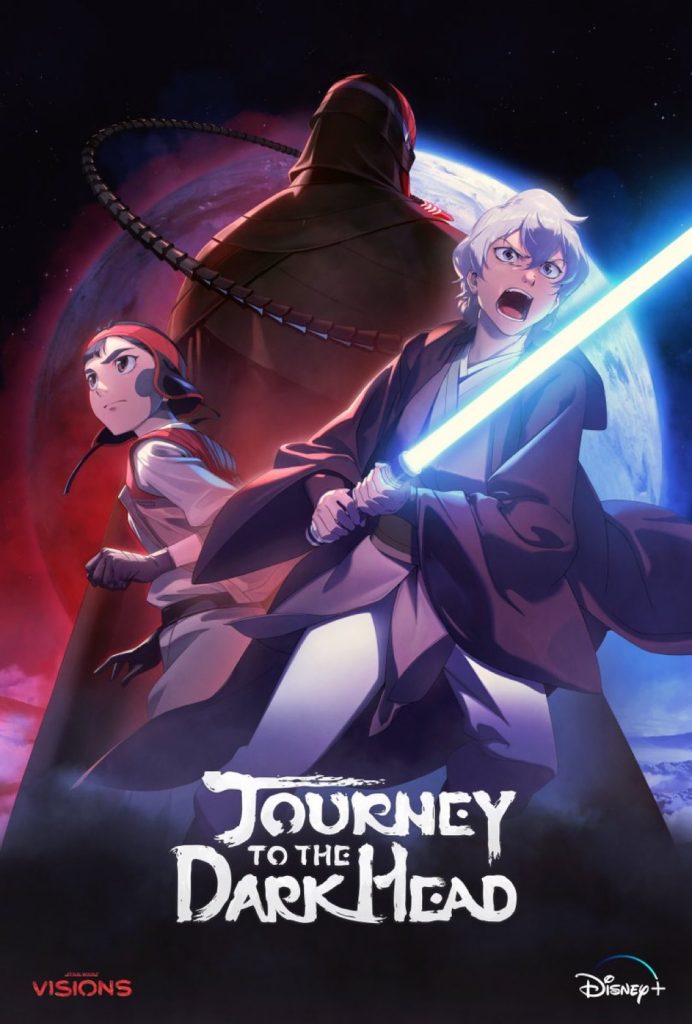
JOURNEY TO THE DARK HEAD
Studio: Studio Mir
Directed by: Park Hyeong Geun
Written by: Chung Se Rang
“A hopeful mechanic and disillusioned young Jedi team up for a risky and unlikely quest to turn the tide of the galactic war, but dark forces tail them.”
Normally I roll my eyes when someone says, “It’s very Star Wars” when referring to something that is in fact, Star Wars they’re watching. But sometimes good is good, and JOURNEY TO THE DARK HEAD, propped up by a very palatable narrative and two sparkling leads, is very good Star Wars.
This short has the most economy to it, meaning it feels analogous to a series or novel adaptation, pedestrian in other words. But that’s not a bad thing, in fact if Star Wars wasn’t accessible then none of us would be here. And after 40+ years, we know that meat and potatoes have the potential be very, very tasty. I mean, the blurb alone could easily be the summary for the 1977 film, and it feels ripped from the pages of an already existing story, but I digress.
To start with, I love the look and feel of the short, and that starts with their decision to use subtitles. As a pretentious asshole who only consumes anime in its native tongue (no dubs); this feels very reassuring to me. And in case you needed any more reasons to enjoy this short, Studio Mir’s resume just happens to include a little series called The Legend of Korra, so.
The odd couple trope is alive and well here as we get Ara (Jang Ye Na) and Toul (Lee Kyung Tae), two hard workers who couldn’t be more different. She’s an idealist; a record keeper of sorts on Dolgarak who desperately wants the war to end and thinks she knows just how to do that. Toul is a hot-tempered conflicted young Jedi who lost his Master in traumatic fashion, thanks to a nasty piece of Sith work named Bichan (Yun Yong Sik). As an aside, Toul’s Master seemed like a total fucking badass and it’s too bad we didn’t get more from her.
Anyways, the Jedi council of the time endorses Ara’s plan and pairs her up with Toul, hoping this assignment will course correct the troubled young Jedi, get him back on track. The wrinkle here is Bichan, who never forgot how good Toul’s fear and anger tasted, can sense the presence of the Jedi, even after all those years. So, Bichan in pursuit, the clock ticking, and the fate of so many at stake, this unlikely duo must figure out how to work together if they hope to succeed.
One thing I’ll say about this season, is that the design of the Sith characters is stellar, and Bichan is no exception, wielding a pretty fucking horrifying lightsaber to boot, and if not for two perfect leads, he would normally be stealing scenes. But the three of them combined do make for an impossibly good hair-raising second half which will have you catching your breath long after it’s over. In it, all the elements of visual storytelling come together in perfect harmony, the sound design (Kim Suk Won) and score (Jang Young Gyu/Lee Byung Hoon) in particular are exceptional.
Make no mistake, despite JOURNEY TO THE DARK HEAD’s homespun feel, there are a lot of wonderful details here, threads that normally would be pulled into oblivion by the company. As such, this short does have the make and feel of a fan-favorite, waiting to be expanded and/or adapted into something more. I don’t feel it’s an accident Toul is front and center on the S2 poster.
Finally, despite my unreasonable take on dubs, there are some notable names on the English voice cast side such as Daniel Dae Kim and Ashley Park.
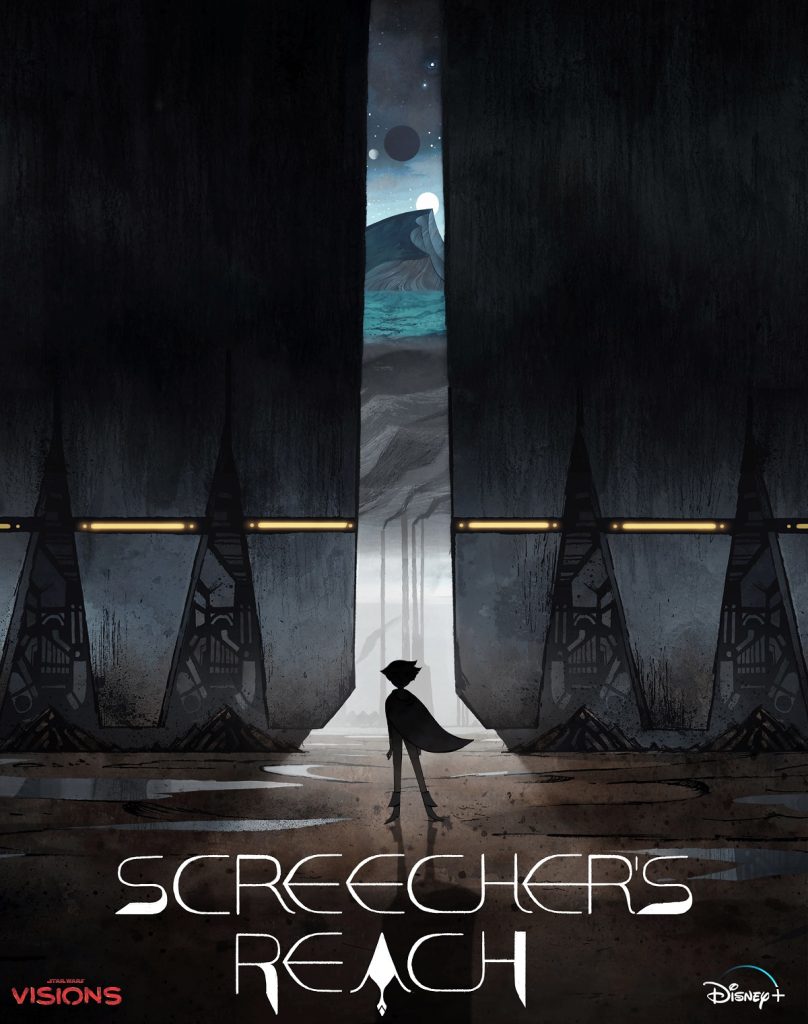
SCREECHER’S REACH
Studio: Cartoon Saloon
Directed by: Paul Young
Written by: Will Collins, Jason Tammemägi
“A young girl, seeking reprieve from her days in a rural workhouse, discovers a legendary haunted cave with her friends. The cave’s dark pull will change the trajectory of her life forever.”
Oh man, I really loved this one, and the affect was almost immediate as I recognized the familiar tone and look from a recent favorite film of mine, 2020’s WOLFWALKERS, from the same studio. Not to mention they brought back that film’s star, bringing back Eva Whittaker (Wolfwalkers) when casting the lead here. The Grimm fairytale esthetic works very well here as this Irish animation studio galvanizes what they’re clearly good at, folksy lore. Indeed, this story would feel right at home amongst some of George Mann’s content, or perhaps more appropriate, his Dark Legends work.
As Daal, Whittaker carries SCREECHER’S REACH on her back, putting forth a tremendous performance, evoking both sympathy and empathy. No easy task in an episode which features Angelica Huston as a Sith Mother, an actor who leaves an indelible mark wherever she goes. The key to this performance, like so many great performances, is in the details. Setting aside the fantastical setting, Daal’s inherent nature gives rise to an understanding that her emotions, her dreams, are very accessible from our perspective. The writers use Daal to petition our own real-world concerns, daring us to self-examine what could be a doldrum existence, hoping the end result is a desire for a deeper engagement with life.
And there’s no better example of this than her “There are better lives” line, which lands like an atomic bomb, so much you don’t even really mind that she goes off with someone who may or may not have her best interests at heart. Part upspeak, part declaration, you BELIEVE that Daal doesn’t have a choice in the matter; she’s a seeker, a dreamer, and to deny it would be to deny her very nature.
The rest of her generative force is slightly more ambiguous as we’re left wondering if her obvious force abilities will lead her down a path of darkness, or light. And as clear as the ending might be for some, I think there’s more going on than what meets the eye. No, Daal’s future is yet unwritten and I wouldn’t so be presumptuous as to deny the existence of her more benevolent side, the question is, which one will win out in the end?
Like a reliable partner, the score in the episode, throughout the entire season really, is a character all its own, with composer Leo Pearson and vocalist Siofra Ni Chasaide nailing the tone and vibe here. Like I said, this will come up often over the nine shorts, but the use of infrasound greatly creates the perfect ambience for this foreboding sedative story. And despite the grim nature and after only two episodes in, Screecher’s Reach had me feeling very optimistic that Season 2 was going to be a good one.
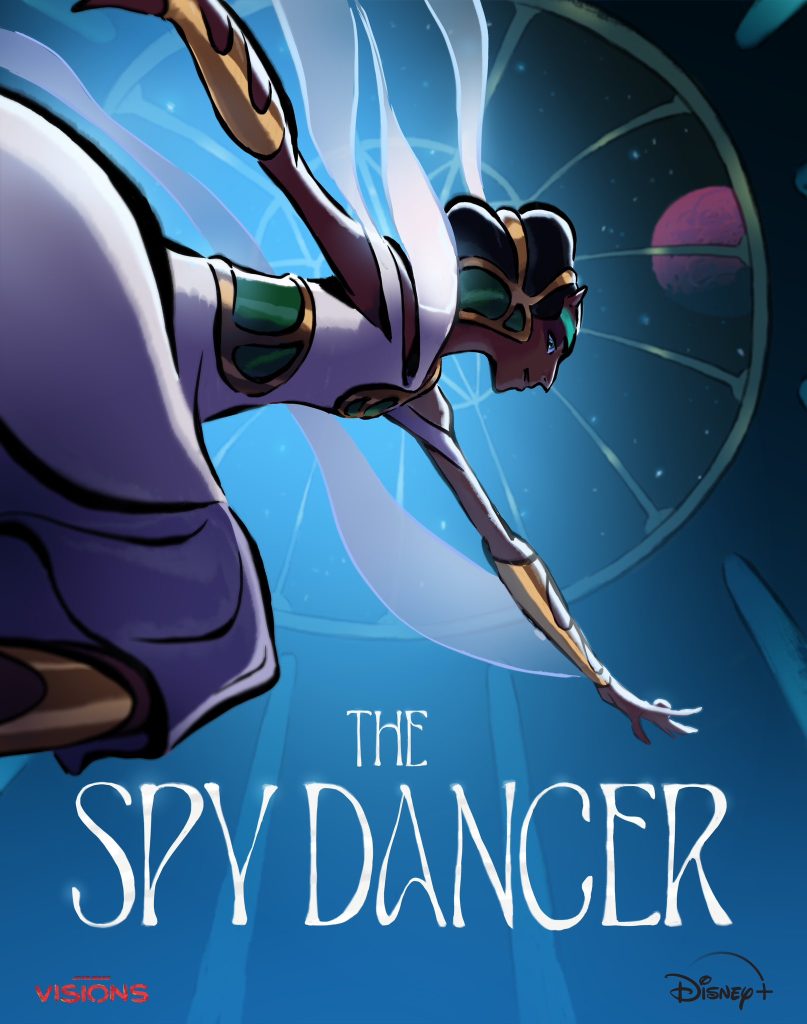
THE SPY DANCER
Studio: Studio La Cachette
Directed by: Julien Chheng
Written by: Julien Chheng, Gabrielle D’Andrimont
“The premier dancer at a famous, Imperial-frequented cabaret uses her unique skill set to spy for the Rebellion, but the presence of a mysterious officer threatens to derail her mission.”
I’m willing to bet this one doesn’t garner too much attention but THE SPY DANCER to me is a wonderful example of allowing these studios to create, rather than impersonate. Drawing inspiration from the French Resistance during World War 2 and the German (Imperial) occupation of France, this short is probably the closest of the bunch to being labeled “a work of art”, colloquially speaking, and that includes a season where an entire episode is literally paint based.
We meet Loi’e (voiced to perfection by Camille Cottin), the star of an aerial silk show at a cabaret which is really a front for some rebels. And like the summary says, Loi’e uses her feminine wiles and implausible acrobatic skills to entertain (distract) Stormtroopers and Officers alike, all the while passing information along to the Rebellion. It’s just a regular sort of night at the club (contextually speaking) when she spots a familiar face amongst the normally faceless crowd, someone from her past, and well, all hell breaks loose. I won’t spoil the ending here but the final third of this short is incredibly dramatic and will leave you wanting more, by design as you’ll see.
Now, whether Loi’e and her team would be Studio La Cachette’s version of the Marquis I don’t know, but they are alike spiritually, born from the same oppressive ashes of fascist authoritarian regimes. And speaking of, this season doesn’t give the Empire too much quarter here, offering very little evidence that they’re nothing but oppressive rapscallions, leaving a trail of death and destruction in their path. And that is key here, how we view the Empire, certainly as top-down organization, and whether the “just following orders” excuse applies to the rank and file, folks serving as instruments to the whim of those monsters at the top. I suppose any generosity you may or may not apply to any who have been coerced into having a sense of agency, will depend on the extremal outcomes of their actions, some acts are more heinous than others after all. This will make loads more sense when you see the short.
One of the wonderful things about the execution here, is you sense the tension in the room almost immediately, it’s thick. Of course, those in attendance are none the wiser, but we understand the continual danger Loi’e puts herself in, the precariousness of the situation. She’s walking a tightrope (pun intended) each and every night and knows that any slip up could light the match, costing many lives in the process. And you don’t need to be an empath to understand the toll it takes on someone who not only surrounds themself with their oppressors, but whose role is to entertain them. Like Mélanie Laurent’s character in Inglorious Basterds, or more agnate, Stellan Skarsgård from Andor, who says, “I yearned to be a savior against injustice without contemplating the cost, and by the time I looked down, there was no longer any ground beneath my feet.”
Unsurprisingly, the analogous score here by Olivier Deriviere is beautiful and tragic, exploratory at times, somber at others. And this is the DNA that brings all the elements together, this noir La Résistance motif that definitely makes this short standout. This is also one of those shorts that gets the most out of a limited run time, replacing laborious dramatic irony with a reliable narrator, all without losing any sophistication in the process.
More than any other it feels like a different time and place, perhaps more recognizable to us than the others because it is more recognizable, a little bit of historical fiction.
“To the Ones We’ve Lost”
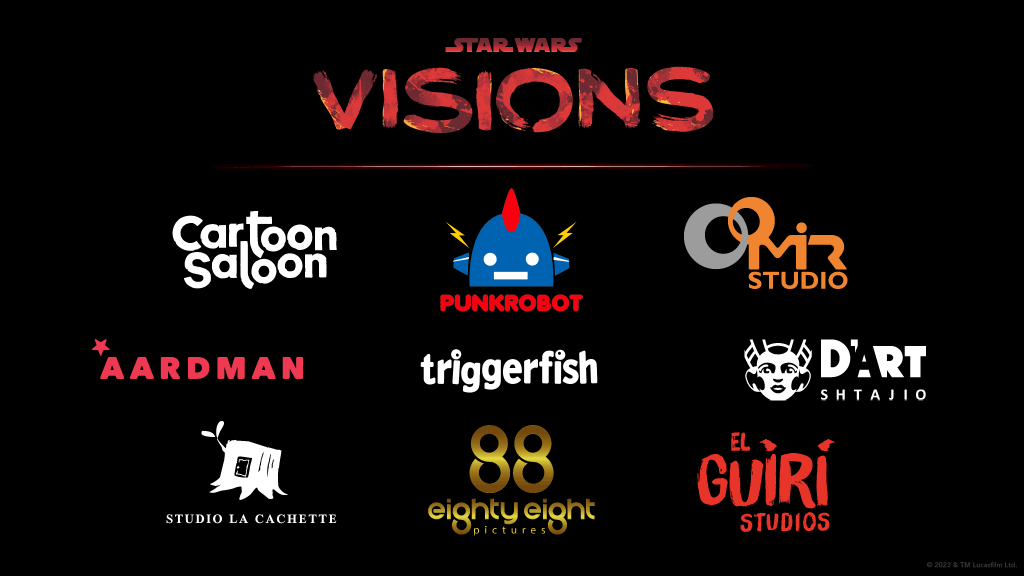
Star Wars: Visions Volume 2 arrives May the 4th on Disney+.
*All images courtesy of Lucasfilm LTD.

